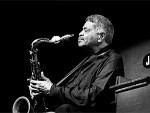Title
Subhead
One reason that New York has held onto the title of Jazz Capital of the World is that it’s a city where scores of musicians have turned up looking to turn outsize talent into stardom. It’s the trajectory followed by Carl Allen, artistic director of Juilliard Jazz, whose career started three decades ago in the midwest, in Minnesota’s Twin Cities. However, on October 16 Allen stages a concert with the Juilliard Jazz Orchestra that addresses the idea of regionalism in the idiom, the reality that some locales left a stamp on musicians that was present long after they’d made pilgrimages north to cities like Chicago and New York. That evening, in a concert called Memphis Jazz With George Coleman and Harold Mabern, the orchestra will be transported to Beale Street, the famed blues thoroughfare in Tennessee.
Body
For obvious reasons, jazz isn’t the first thing that comes to mind when thinking of this Southern city. Beale Street is where various forms of earthy music intersected in the personages of B. B. King, the crew at the legendary label Sun Records spearheaded by Elvis Presley, and later R&B figures Isaac Hayes and Al Green. “I’m not even sure that the people there now know we even existed,” said special guest saxist George Coleman, who left Memphis for Chicago just out of his teens in the mid-’50s, having already toured with King and written arrangements for Ray Charles. “B.B. actually bought me my first tenor sax,” Coleman recalled in an interview with The Journal. “I was playing alto at first, but B.B. needed a tenor in his band.” Switching saxes would serve the now 77-year-old saxist well; he went on to make jazz history on recordings led by Miles Davis (Seven Steps To Heaven, Four & More) and Herbie Hancock (Maiden Voyage).
In a clever way, the Memphis theme helps Allen stress fundamentals. Jazz education wasn’t nearly as extensive as it is today when Coleman and the concert’s other special guest, pianist Harold Mabern, were learning to swing. Mabern, whose credentials include stints with guitar icon Wes Montgomery and trumpet crossover star Lee Morgan, has been on the faculty of Allen’s alma mater, William Paterson University, for three decades. “I think of myself as a blues pianist who understands jazz,” Mabern once told Jazziz magazine. “As we go into each academic year, I usually have a working theme in my head,” Allen told The Journal. “I’ve kinda decided that this is the Year of Rhythm at Juilliard, because what I’m noticing with quite a number of younger musicians is that even though they’re very proficient technically—in some cases, even better than we were when I was coming up—what’s missing is the feeling and the timing. A big part of the message of this concert is about the feeling of the music, how integral that should also be to our studies.”
Ironically, Allen’s first encounters with Coleman and Mabern in the ’80s give an interesting twist to his thoughts on the difference between jazz erudition then and now. “Harold was in George’s group when I started doing gigs with them,” Allen recounted, “and you have to understand that at that point, they’d already been playing together something like 40 years. There were some nights that they’d pull out tunes or get into harmonic things on the bandstand that made me relieved that I was on drums rather than a chordal instrument. I’d never heard some of this music, so I’d be thinking, ‘well, let me just sit back here and keep good time, because if I was a bass player or pianist I’d be in a world of trouble trying to keep up with these cats.’”
Both Coleman and Mabern are familiar with the many other great Memphis jazz figures celebrated in the concert, pianists such as Phineas (pronounce “Fine-uss”) Newborn Jr. and James Williams, trumpeter Booker Little, and saxophonist Frank Strozier, because they shared bandstands with them. A conversation with Coleman quickly turns into a front-row reminiscence of the jazz hotbed that launched many careers, from long-forgotten Beale Street clubs like Miller’s Hotel (“Elvis would stop by to check out music there”) to the rivalry between the two high schools with the finest musicians, Manassas High and Booker T. Washington. “I went to Manassas,” Coleman said. “So did Harold. I also played some clubs just across the state border in West Memphis, Ark., with a group led by genius pianist Phineas Newborn Jr.’s father.”
“My jazz upbringing and experience in Memphis carried me through when I came to Chicago in 1956,” Coleman said, “because by then a few of us had moved there, like Harold and Frank Strozier. The Chicago cats were like, ‘Who are all these guys, who know all these tunes and can play the blues, too?’” What’s astonishing is that all this took place in the space of a few years; Coleman was just 20 when he migrated to the Windy City. He would relocate to New York within the next two years to join drummer Max Roach’s band. “That’s when I was doing what I really wanted to do,” he explained, his voice rising enthusiastically. “Even though the places in Memphis weren’t too big on letting us play bop, the records we were listening to and studying were [bebop architect] Charlie Parker’s records. Max had played with Charlie Parker, so I don’t have to tell you how big a deal that was for me.” The saxist pauses for emphasis. “Of course, Max didn’t mind that by that time I knew the blues inside and out.”





